Male Vs Female Spirituality: Cultural!
The distinction between male and female spirituality encompasses historical, cultural, and biological aspects that influence how individuals experience and express their spiritual beliefs.
Male and female spiritual experiences often differ in terms of practices, interpretations, and societal roles, reflecting the diverse tapestry of human spirituality.
Gendered spirituality is a multifaceted concept that includes:
- Historical Dimension: Throughout history, men and women have held different roles in spiritual and religious contexts. For example, in many traditions, men have predominantly been the leaders and decision-makers, while women’s roles were more supportive or domestic.
- Cultural Dimension: Cultural norms and values shape the way spirituality is expressed. In some cultures, women may be seen as more intuitive or spiritually attuned, leading to gender-specific spiritual practices.
- Biological Dimension: Biological differences can also play a role in shaping spiritual experiences. For instance, childbirth and motherhood are profound experiences that can have a unique spiritual significance for women.
Exploring the nuanced spiritual paths of both men and women offers insights into the rich and varied landscape of human spirituality, fostering inclusivity and understanding within spiritual communities.

Key Takeaway
Historical Perspectives on Gendered Spirituality
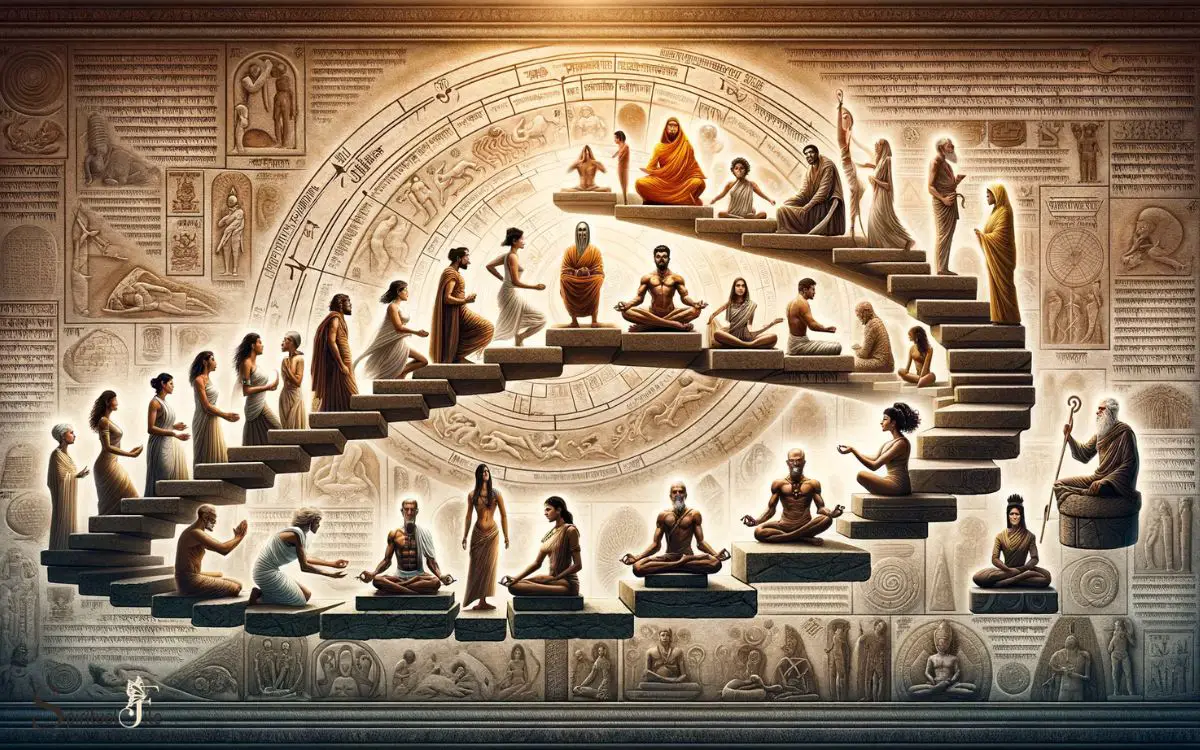
In examining historical perspectives on gendered spirituality, it is essential to consider the cultural and societal influences that have shaped the understanding of male and female spirituality over time.
Throughout history, various cultures have ascribed specific spiritual roles and characteristics to men and women. In many societies, male spirituality has been associated with attributes such as strength, leadership, and assertiveness, often aligned with the divine or the transcendent.
On the other hand, female spirituality has been linked to nurturing, intuition, and interconnectedness, often associated with the earth or immanent aspects of spirituality.
These gendered spiritual perspectives have been perpetuated through religious teachings, societal norms, and traditional practices, contributing to the formation of distinct roles and expectations for men and women within spiritual contexts.
Understanding the historical roots of these gendered spiritual perspectives is crucial for comprehending contemporary views on male and female spirituality.
Cultural Influences on Male and Female Spiritual Roles
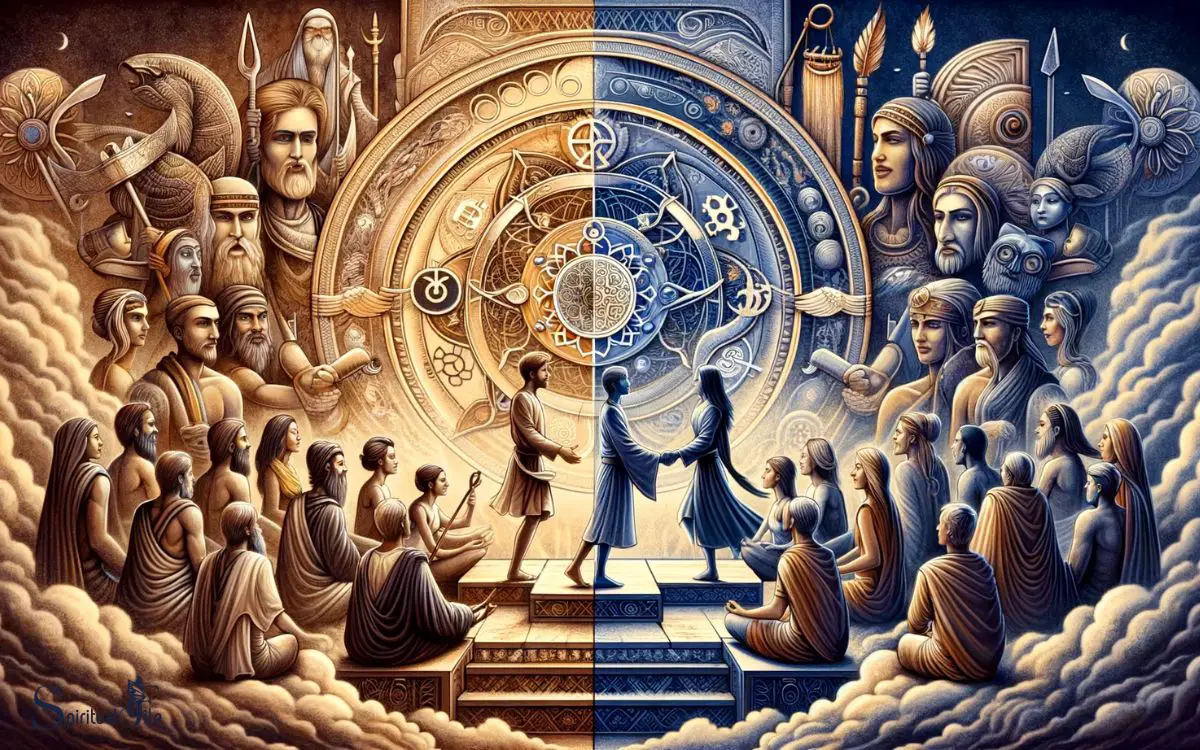
Cultural influences on male and female spiritual roles have been perpetuated through religious teachings, societal norms, and traditional practices, contributing to the formation of distinct roles and expectations for men and women within spiritual contexts.
These influences shape the way men and women perceive their roles in spirituality and the expectations placed upon them by their respective cultures.
The following table outlines some key cultural influences on male and female spiritual roles:
| Cultural Influence | Male Spiritual Roles | Female Spiritual Roles |
|---|---|---|
| Religious Teachings | Often emphasize leadership and | Often emphasize nurturing and |
| authority in spiritual matters | support roles in spiritual | |
| contexts | ||
| Societal Norms | Tend to encourage stoicism and | Tend to promote empathy and |
| self-reliance as spiritual | communal aspects of spirituality | |
| virtues | ||
| Traditional Practices | Often involve rituals and | Often involve caretaking and |
| ceremonies that reinforce | domestic responsibilities | |
| traditional gender roles |
Understanding these cultural influences is essential in comprehending the complexities of male and female spiritual roles. This sets the stage for exploring how biological factors further shape gendered spiritual experiences.
Biological Factors in Gendered Spiritual Experiences

The biological factors that contribute to gendered spiritual experiences are multifaceted, encompassing the influence of brain chemistry and hormonal fluctuations.
Understanding the interplay between gender and brain chemistry sheds light on the variations in spiritual experiences between males and females.
Moreover, exploring the impact of hormonal influences on spirituality provides valuable insights into the distinct ways in which men and women may engage with their spiritual beliefs and practices.
Gender and Brain Chemistry
Gender’s influence on brain chemistry plays a crucial role in shaping individuals’ distinct spiritual experiences. This influence is rooted in biological factors that contribute to differences in how males and females experience spirituality.
The following factors help elucidate the relationship between gender, brain chemistry, and spiritual experiences:
- Neurotransmitter levels: Variances in neurotransmitters, such as serotonin and dopamine, impact mood regulation and emotional responses, which can influence spiritual experiences differently in males and females.
- Hormonal fluctuations: Varied hormonal levels in males and females can affect emotional and cognitive processes, potentially leading to different spiritual perceptions and practices.
- Brain structure and function: Variances in brain structure and function, including hemispheric dominance, may contribute to gender-specific spiritual inclinations and experiences.
- Genetic predispositions: Varied genetic factors can influence the development and functioning of the brain, potentially shaping gender-specific spiritual experiences.
Hormonal Influences on Spirituality
Hormonal fluctuations significantly impact the spiritual experiences of males and females due to their influence on emotional and cognitive processes.
For females, the menstrual cycle, pregnancy, and menopause are associated with hormonal shifts that can affect mood, cognition, and spiritual experiences.
Estrogen and progesterone levels can influence emotional sensitivity, empathy, and intuition, potentially shaping the way women connect with their spirituality.
In males, testosterone levels can also impact emotional regulation and cognitive functions, affecting their spiritual experiences.
These hormonal influences highlight the interconnectedness of biology and spirituality, emphasizing the need to consider gender-specific biological factors in understanding spiritual experiences.
Understanding these hormonal influences can provide insight into the diverse ways in which males and females engage with and perceive spirituality, shedding light on the complexity of gendered spiritual experiences.
This understanding sets the stage for exploring differences in male and female spiritual practices.
Differences in Male and Female Spiritual Practices

Diversity in spiritual practices is evident between males and females, reflecting distinct approaches to connecting with the divine.
While spiritual practices are deeply personal and individualized, there are some general differences in how men and women engage in them. These differences can be influenced by cultural, societal, and personal factors, leading to varied expressions of spirituality.
Some of the key differences in male and female spiritual practices include:
Rituals and Ceremonies: Males and females may participate in different religious rituals or ceremonies based on traditional gender roles and expectations.
Community Engagement: Females often seek spiritual connection through community involvement and nurturing relationships, while males may prioritize individual experiences.
Expressions of Devotion: Women may express devotion through acts of service and caregiving, while men may focus on rituals or intellectual pursuits.
Approach to Meditation: Females may prefer meditation practices that emphasize emotional healing and connection, while males may gravitate towards meditation for clarity and focus.
Societal Expectations and Gendered Spiritual Expression
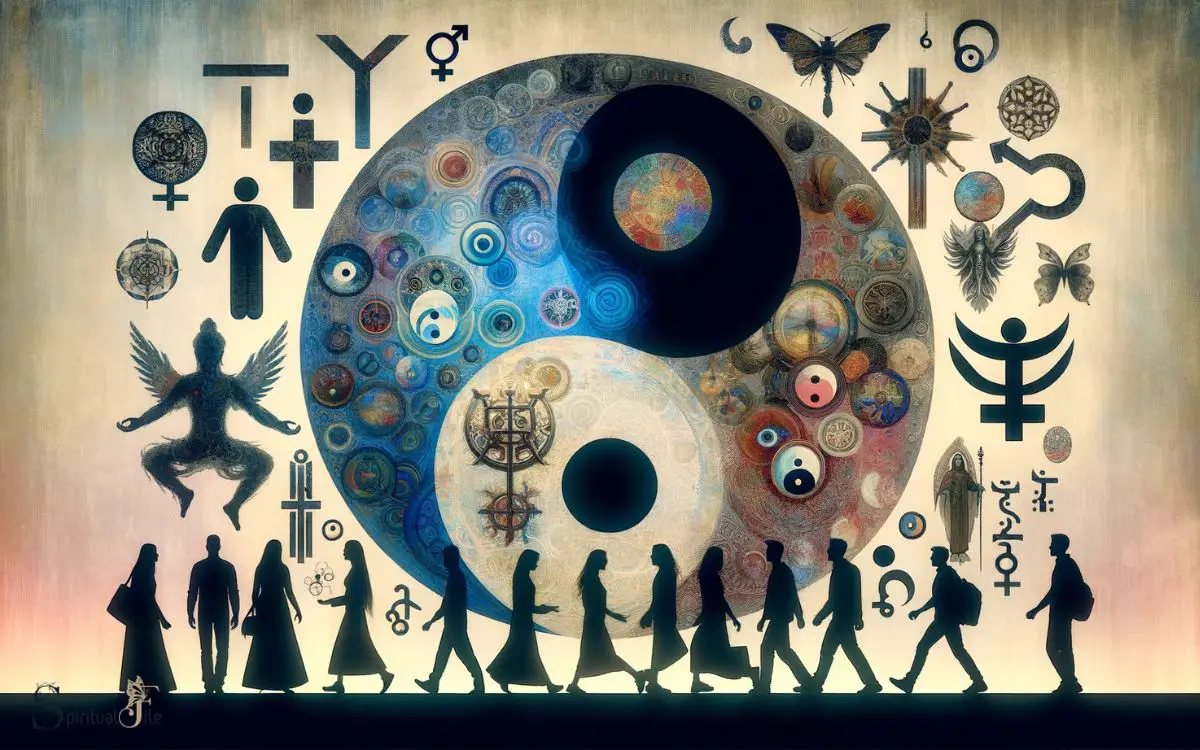
Societal expectations significantly influence the gendered expression of spirituality, shaping the distinct approaches that men and women adopt in their spiritual practices.
These expectations often dictate how individuals are supposed to express their spirituality based on their gender, leading to different manifestations of spiritual beliefs and practices.
The following table illustrates some societal expectations that influence the gendered expression of spirituality:
Certainly, here’s a revised table that presents societal expectations for gendered spiritual expression more clearly:
| Gender Expectations in Spiritual Roles | Men | Women |
|---|---|---|
| Leadership Roles | Expected to demonstrate strength and leadership in their spiritual roles. | Often encouraged to be nurturing and supportive within spiritual communities. |
| Public vs. Private Expression | Expected to engage in more public and visible forms of spiritual leadership. | Encouraged to focus on personal and private forms of spiritual expression. |
Understanding these societal norms is crucial in comprehending the diverse ways in which men and women engage with their spirituality. This insight sets the stage for exploring how gendered interpretations of sacred texts and teachings further influence spiritual practices.
Gendered Interpretations of Sacred Texts and Teachings
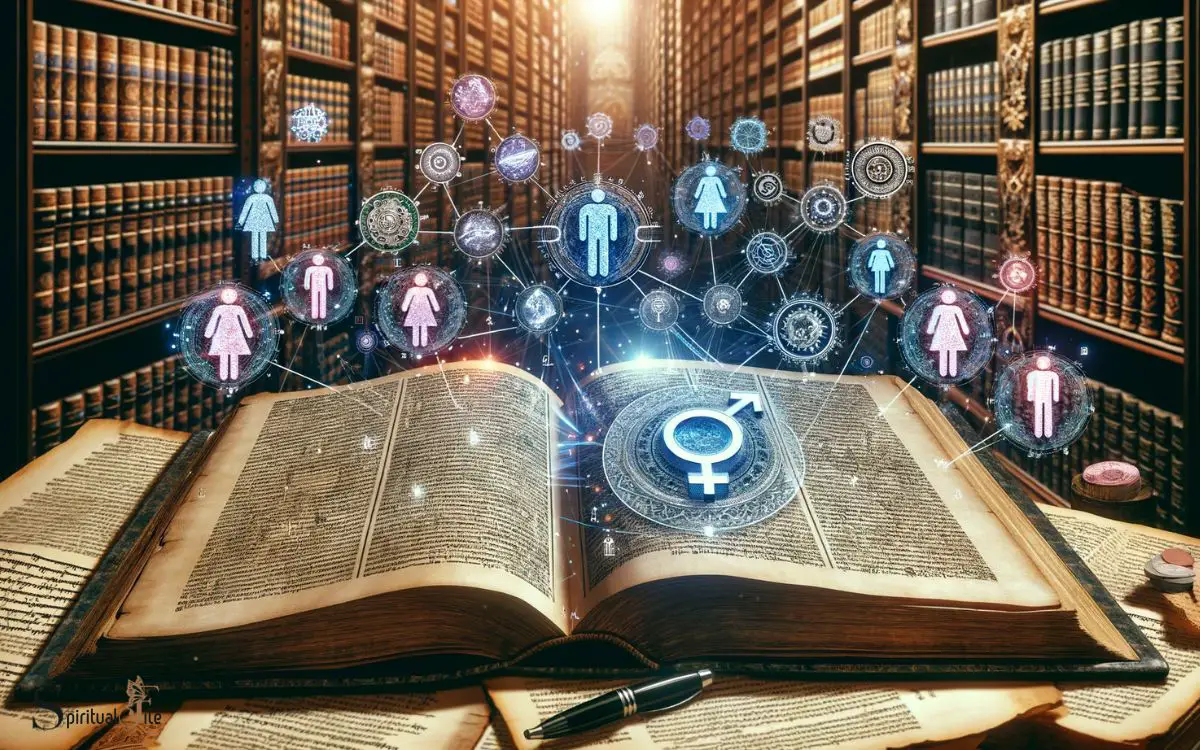
Many scholars have noted that a significant proportion of sacred texts and teachings have been traditionally interpreted through a predominantly male lens, influencing the gendered understanding and application of spiritual principles.
This gendered interpretation has resulted in various implications for individuals and communities practicing these spiritual traditions:
- Limited perspectives: Male-centric interpretations may overlook or undervalue the experiences and insights of women within the sacred texts.
- Reinforcement of gender roles: Traditional interpretations may reinforce gender stereotypes and roles, impacting the societal expectations and roles within religious communities.
- Inequitable treatment: Gendered interpretations can contribute to inequality in religious practices, leadership roles, and access to spiritual knowledge and authority.
- Impact on personal spirituality: Individuals may experience limitations in their own spiritual development and self-understanding due to these gendered interpretations.
As we explore contemporary debates on gender and spirituality, it is crucial to consider the impact of historical interpretations on current understandings and practices.
Contemporary Debates on Gender and Spirituality
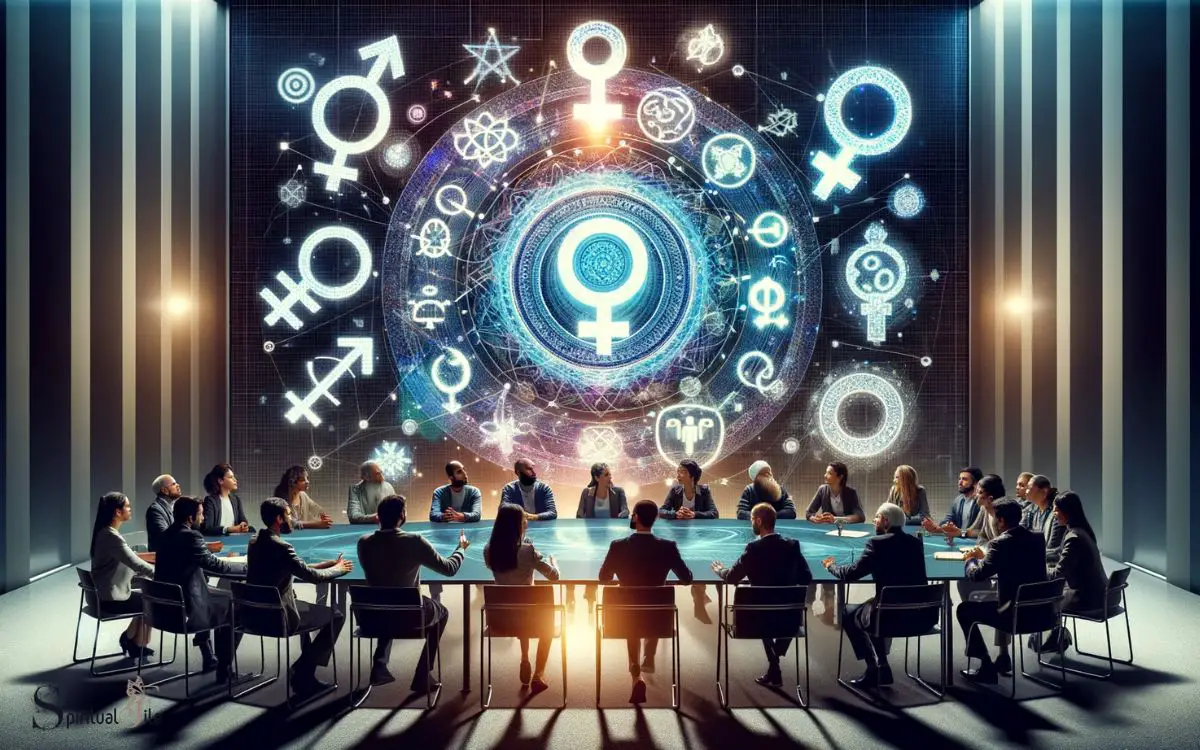
Building upon the gendered interpretations of sacred texts and teachings, contemporary debates on gender and spirituality continue to shape the understanding and practice of religious traditions.
These debates encompass a wide range of topics, including the role of women in religious leadership, the inclusion of LGBTQ+ individuals in religious communities, and the representation of diverse gender identities in spiritual practices.
The table below outlines some key points in these ongoing debates, aiming to evoke a deeper understanding of the complexities involved.
| Debate Topic | Key Points | Implications |
|---|---|---|
| Women in Religious Leadership | Ordination, pastoral roles, and decision-making | Impact on gender equality within religions |
| LGBTQ+ Inclusion in Religious Spaces | Acceptance, marriage, and religious participation | Influence on inclusivity and acceptance |
| Representation of Diverse Gender Identities | Recognition, language, and rituals | Effect on visibility and affirmation |
Embracing Gender Diversity in Spiritual Communities
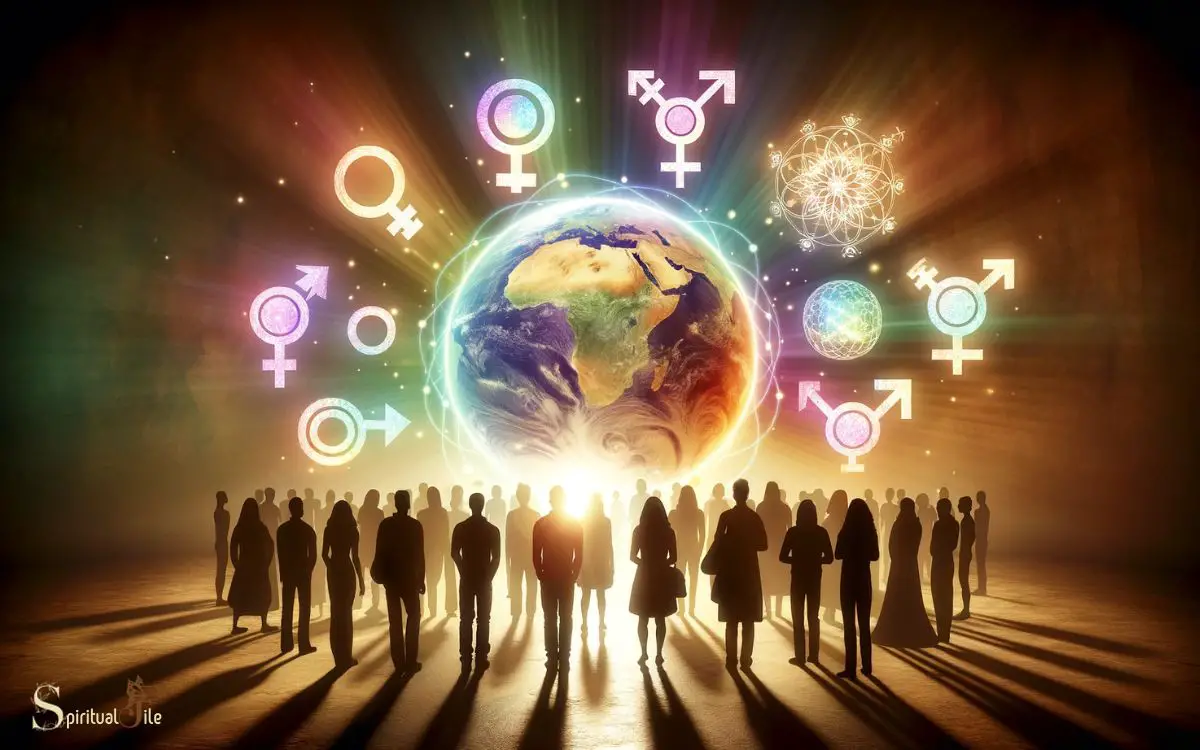
Embracing gender diversity in spiritual communities requires intentional and inclusive practices.
To achieve this, spiritual communities can consider the following:
- Education and Awareness: Providing education on gender diversity and creating awareness about the challenges faced by individuals with diverse gender identities can foster understanding and empathy within the community.
- Inclusive Language and Imagery: Adopting inclusive language that embraces all gender identities and ensuring that imagery used in spiritual spaces reflects diversity can help create a welcoming environment for everyone.
- Diverse Leadership Representation: Encouraging and supporting individuals of diverse gender identities to take on leadership roles within the spiritual community can promote inclusivity and representation.
- Supportive Policies and Practices: Implementing policies that prohibit discrimination based on gender identity and providing support systems for individuals navigating gender diversity can foster a safe and supportive environment within the spiritual community.
How Does the Energy of the Full Moon and New Moon Affect Male and Female Spirituality Differently?
The full moon energy comparison on male and female spirituality reveals distinct effects. For women, the full moon fosters emotional introspection, amplifies intuition, and evokes a connection to their cyclic nature. In contrast, men may experience increased vitality, intensified desires, and a sense of power during the full moon. While both genders are influenced, the impact on their spiritualities varies, reflecting the diverse paths of personal growth.
Frequently Asked Questions
Can Spirituality Be Completely Divorced From Gender, or Is It Inherently Tied to Masculine and Feminine Qualities?
Spirituality transcends gender, encompassing universal themes of connection, purpose, and inner growth.
It manifests in various forms and can be experienced by individuals regardless of gender. While gender may influence spiritual expression, the essence of spirituality is not inherently tied to masculine or feminine qualities.
How Do Transgender and Non-Binary Individuals Fit Into the Traditional Gendered Roles and Practices of Spirituality?
Transgender and non-binary individuals challenge traditional gendered roles and practices of spirituality, necessitating a reevaluation of inclusivity and understanding.
Their unique experiences and perspectives enrich the spiritual landscape, prompting a more expansive and inclusive approach.
Are There Specific Spiritual Experiences or Teachings That Are Unique to Individuals Who Do Not Conform to Traditional Gender Norms?
Individuals who do not conform to traditional gender norms may have unique spiritual experiences and teachings that reflect their personal identities.
Understanding and respecting these diverse perspectives can enrich the broader spiritual community and foster a more inclusive environment.
How Do Societal Attitudes Towards Gender and Spirituality Impact the Inclusivity and Diversity of Spiritual Communities?
Societal attitudes towards gender and spirituality deeply impact the inclusivity and diversity of spiritual communities.
These attitudes can create barriers for individuals who do not conform to traditional gender norms, hindering their ability to fully participate in and benefit from spiritual communities.
What Are Some Practical Ways to Challenge and Dismantle Gendered Expectations Within Spiritual Practices and Communities?
Some practical ways to challenge and dismantle gendered expectations within spiritual practices and communities include promoting inclusive language, offering education on gender diversity, and creating safe spaces for open dialogue and exploration.
Conclusion
The intersection of gender and spirituality is a complex and multifaceted topic that is influenced by historical, cultural, biological, and societal factors.
As we continue to explore and understand the differences in male and female spiritual experiences, it is important to embrace gender diversity in spiritual communities.
Like a tapestry woven with different threads, the diversity in gendered spirituality enriches our understanding and appreciation of the spiritual journey.






